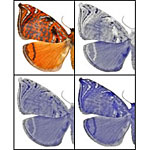
| home | catalogue | host plants | library | TORTS | tortriciDNA | about | site map |
|
Pest TortricidsMany tortricids are important agricultural pests and the family contains a large number of pest species. Zhang (1994) lists 687 tortricids as economically important, a number third only to the highly diverse Noctuidae, with 1034 pest species, and Pyralidae (+ Crambidae) with 748 recognized pest species. The economic importance of the family is demonstrated by the amount of publications dedicated to the biology, physiology, identification, and control of tortricid moths, and entire volumes have been published on these subjects (e.g., van der Geest and Evenhuis 1991). Perhaps there is no better example of a ubiquitous tortricid pest than the "worm" that is found after biting into an apple, which is actually the larva of the codling moth, Cydia pomonella (L.). This page contains links to other websites dedicated to tortricid pests. TortAI: Tortricids of Agricultural Importance by Todd M. Gilligan and Marc E. Epstein Released in 2012, Tortricids of Agricultural Importance (TortAI) is designed to aid in the identification of tortricid adults encountered during domestic surveys and tortricid larvae encountered during quarantine inspections at U.S. ports of entry. This resource includes interactive identification keys, detailed fact sheets, an illustrated glossary, information on dissecting and preparing specimens, identification thumbnail galleries, and a database of DNA barcode sequences. The interactive identification keys run as a Lucid3 Java Applet. TortAI can be accessed at the following URL:
LBAM ID: Tools for diagnosing light brown apple moth and related western U.S. leafrollers (Tortricidae: Archipini) by Todd M. Gilligan and Marc E. Epstein Released in 2009, LBAM ID is designed to aid in the identification of adult or larval Lepidoptera encountered during LBAM surveys in California. This resource includes interactive identification keys, images, diagrams, fact sheets, and a DNA sequence database. LBAM ID was created through a federal-state collaboration among USDA/APHIS/PPQ/CPHST, California Department of Food and Agriculture (CDFA), and Colorado State University (CSU). LBAM ID was developed and released in Lucid version 3.4 software and uploaded to the Internet to support easy access by PPQ, CDFA and other cooperators. LBAM ID can be accessed at the following URL:
|
Please do not download, copy, print, or otherwise distribute any images from these
pages without the permission of the author. Contact Form.


